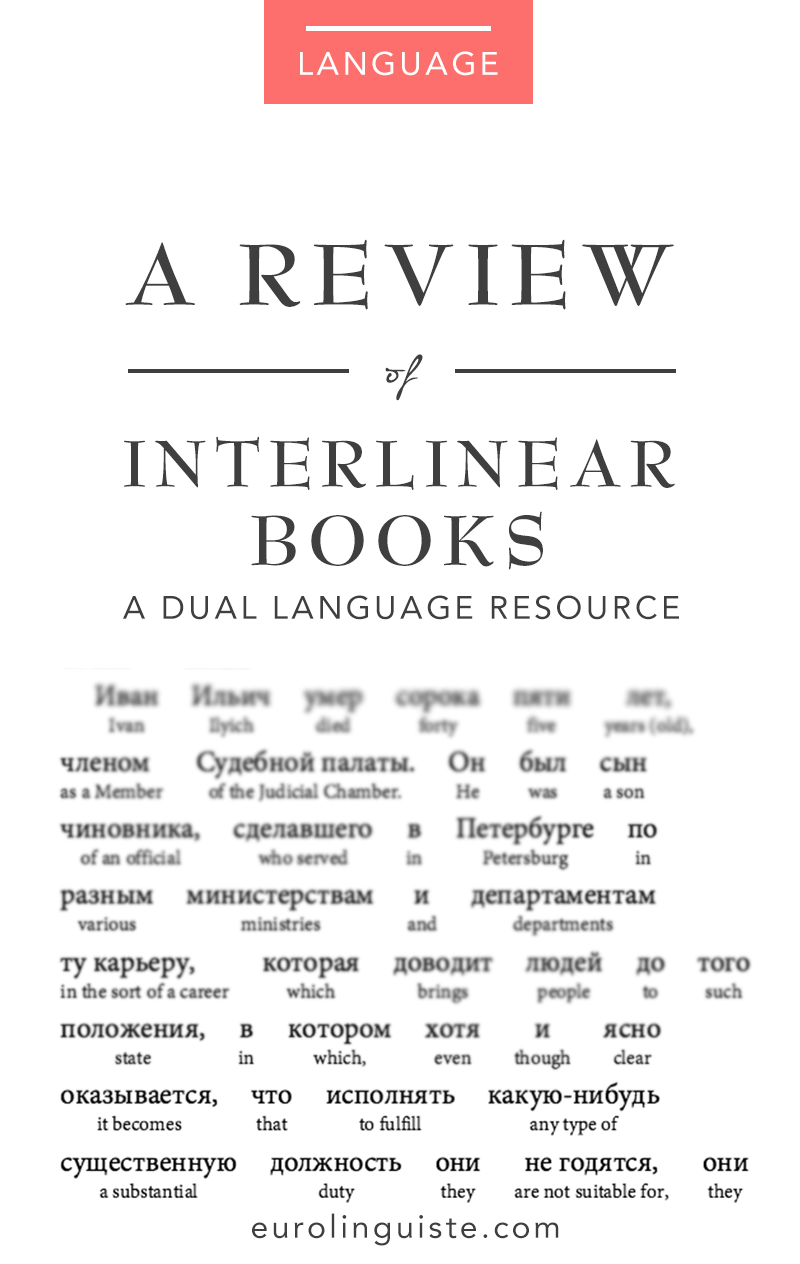Interlinear Books Review| A Dual Language Book

My name is Shannon Kennedy and I'm the language lover,…
I discovered my first dual language book while at FNAC in France quite a few years ago. It was before language learning became something that I actively pursued, but I cherished that book. In fact, it still has a place on my bookshelf right above my desk.
It was a French-English version of Sherlock Holmes that offered a side-by-side translation of the text. (And you know how much I love Sherlock Holmes.)
Up until that point, I had never seen anything like it. I loved that I could read one of my favorite series in the language of my choice, with the translation right there. It definitely beat the two book method I had been using (you guys, it’s really hard to work with two books open at the same time).
But I still felt like there was room for improvement. Despite the fact it was easier than what I had been doing, I still had a hard time bouncing back and forth between the two pages. I often lost my place and it really slowed me down.
Then I discovered Interlinear Books.
Who are Interlinear Books?
Interlinear Books is a company that publishes bilingual books with the text in both the original language and a translation in English in smaller letters immediately below.
The company is run by a group of students at the University of Cambridge. The books are available through all platforms, although some are in beta (the epub versions). I tried both the PDF on my computer and the epub version on my phone and did not have a problem with either (except that I was not able to change the size of the font on my pub version).
They currently have eight different books available, each in a different language including:
- Un Coeur Simple // A Simple Heart by Gustave Flaubert (French)
- Die Verwandlung // The Metamorphosis by Franz Kafka (German)
- El Coloquio de Los Perros // The Colloquy of the Dogs by Miguel de Cervantes (Spanish)
- Trumpos Istorijos // Short Storms by Jonas Biliunas (Lithuanian)
- Ο συντηρητής // The Clockmaster by Roubina Gouyoumitzian (Greek)
- Skatten // The Treasure by Selma Lagerlöf (Swedish)
- O Alienista // The Alienist by Machado de Assis (Portuguese)
- Смерть Ивана Ильича // The Death of Ivan Ilyich by Leo Tolstoy (Russian)
My Interlinear Books Review
The book that I read was “The Death of Ivan Ilyich” by Leo Nikolayevich Tolstoy, 1st edition. It is a Russian-English dual language book of 187 pages (that’s over 18 thousand translated words) in total as a PDF. For those of you unfamiliar with the text, it is a renowned and thought-provoking work on the subject of death and dying. Despite being only and not a full-on novel, novella, it was still an intense read. How could it not be when the discussion surrounds mortality and whether or not one has wasted their life? Still, the work is short, so despite the thoughtful subject – and in another language, the book wasn’t inaccessible (like some works of classic literature can be).

Things I Really Like About Interlinear Books
The spacing between words and lines // There is a lot of white space, but not too much and it makes it really easy to work through the text without being intimidated by huge black blocks of words. It also gives you the sense that you are moving through the book quickly which adds to your sense of accomplishment.
The translations are accurate and understandable // The translations are done by real people (not machines), so a lot of thought is put into them and they are really well done. They’ve gone out of their way to choose the most appropriate translations, even when it means translated word ‘units’ rather than each individual word.
The variety of formats available to you after you purchase a book // I love that they have a variety of formats available to you depending on the advice you prefer. I’m a Kindle user at heart, but I don’t mind reading with a PDF of my computer or with iBooks on my phone. There were a lot of choices, and so you’ll definitely find something that works for you.
It’s great for a beginning reader // Which I am in Russian. I wouldn’t say to start with this resource unless you have a basic working vocabulary, and the ability to read the writing system of your target language, but I picked up quite a bit of new vocabulary and grammar working through my book. Because the translation is readily available to you, it’s somewhat easier to work through than a graded reader might be (we’re you mostly on your own). It can be as much of a challenge as you want it to be depending on how much and how often you choose to rely on the English translation, and for that, I think it’s wonderful.
The Not So Great Stuff
There wasn’t much I didn’t like about the book itself, but there are a few things I’d like to point out.
The books are anywhere from $12.99 to $29.99 // That’s a pretty big price for less than 200 pages a pop.
The limited catalog // The books are only available in eight languages and there is only one book per language. They are also relatively short. I’d really like to see them develop their book selection a bit more, but considering the time and cost to do so, I understand why they haven’t yet.
Reading with interlinear books does tempt one to cheat // Because the translations are only just below the words in your target language, it’s easy to read lazily, glancing down more often than necessary. It definitely takes some measure of self-discipline to avoid the temptation and search your own mental dictionary in an attempt to understand the text before resorting to the translation.
My Conclusion Regarding Interlinear Books
Interlinear Books was my introduction to interlinear translations. I take notes much in the same way, translating new words immediately below, so it really appealed to my established language learning style.
In general, I’m a huge fan of dual language books. I think that the different dual language book formats serve different levels and types of learners. For example, a more advanced reader might opt to go with the side-by-side dual language books as their less likely to need to check the meaning of a sentence or word often. Interlinear Books, however, are really great for someone just starting out because the translations are just below what you’re reading.
I really enjoyed working through Tolstoy’s book in this way. I love that I can read a classic work in its original language, but still have some help getting through it. I’d like to see Interlinear Books continue to develop their catalog – which I’m sure they’re working on – and I can’t wait to see what they have in store for the future. It will definitely be a resource I continue to use when more options in my target languages are added.

Do you have any experience with dual language books? If so, I’d love to hear about them in the comments below!
What's Your Reaction?
My name is Shannon Kennedy and I'm the language lover, traveler, and foodie behind Eurolinguiste. I'm also the Resident Polyglot at Drops and the Head Coach of the Fluent in 3 Months Challenge.



